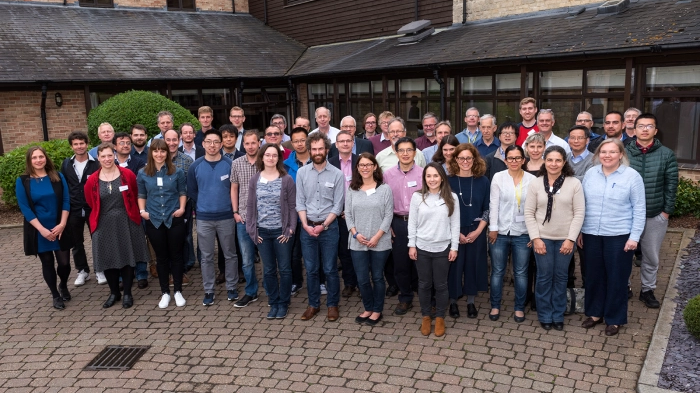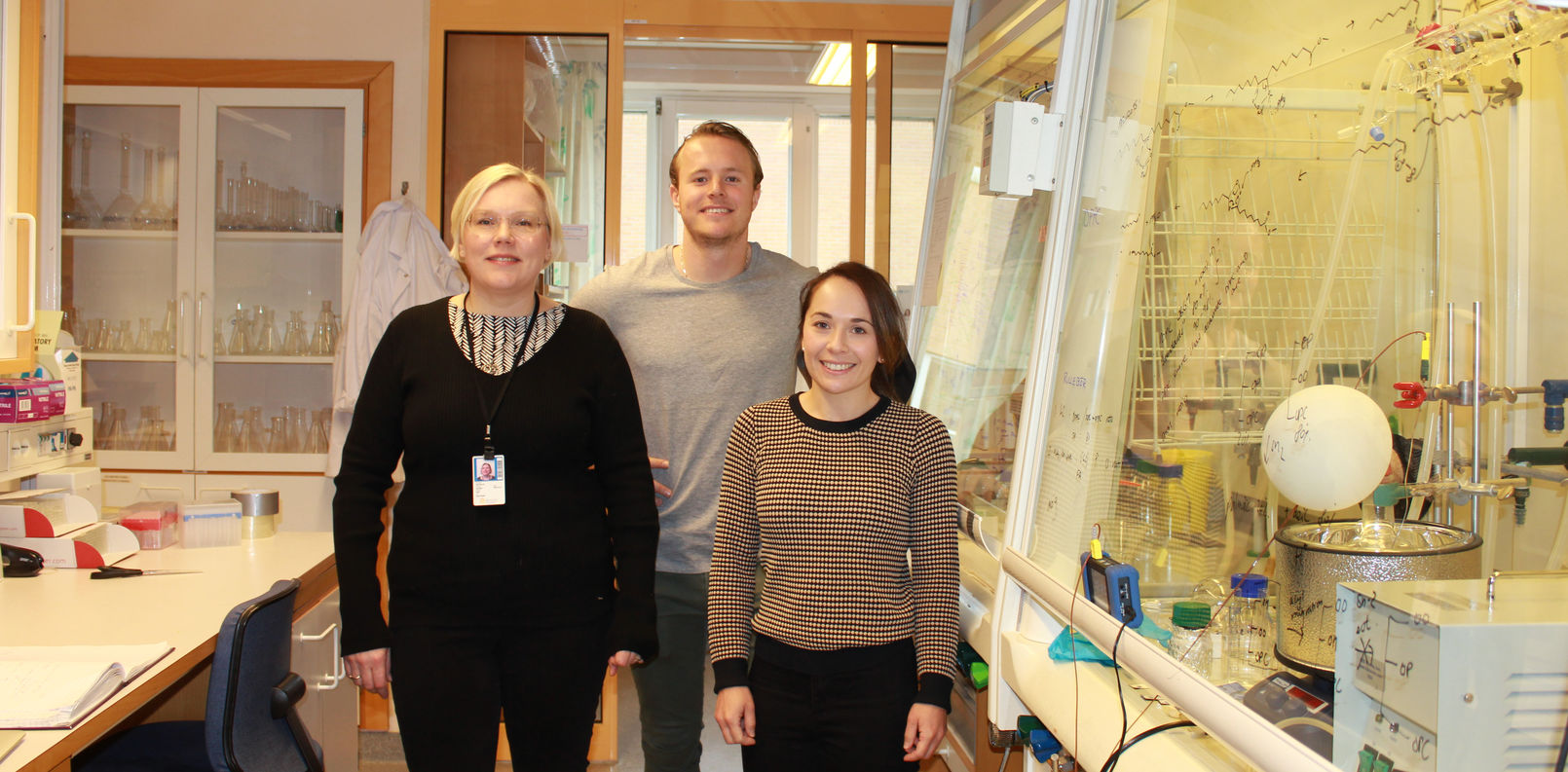The BrightnESS² Deuteration Pilot: Developing new methods and stronger networks for life science research with neutrons

Above: Early DEUNET meeting in Oxford, UK, where the pilot was first conceived |
Deuteration is the swapping out of hydrogen atoms with deuterium atoms in a given sample—a protein or a lipid for example. The efficient production of quality deuterated samples is essential for the exploitation of certain classes of neutron instruments, and is a key element in the science case for several of the novel instruments designed for the European Spallation Source (ESS).
By essentially “labelling” hydrogen molecules with deuterium, the process allows an instrument’s neutron beam to interact with the sample’s hydrogen, providing data critical to understanding biological processes. This can mean that the researcher using a deuterated sample is able to, for instance, locate the precise position of a hydrogen molecule or trace interactions between a deuterium-labelled hydrogen-containing component and an unlabelled one. These techniques exploit critical advantages that neutron probes have over X-ray probes, which struggle to observe atoms of hydrogen, and to differentiate between its isotopes. Being able to distinguish between a model cell membrane and a drug molecule, for example, has contributed to the development of precisely targeted cancer therapies and better anti-viral drugs.
Making the impossible possible
Deuteration, however, is a specialised and time-consuming laboratory process, and there are only a handful of places in the world that a researcher can appeal to for this work. Subsequently, there is high demand and short supply, and research opportunities are delayed or lost. Neutron sources and deuteration labs have therefore banded together to improve this situation in two ways: by developing a global network of the relevant labs in order to coordinate and streamline the deuteration pipeline (the Deuteration Network, or DEUNET, initiated in 2016); and by developing new methods of deuteration that will speed up the process, improve the quality of deuterated samples, and continuously expand the range of deuterated molecules available for research.
The BrightnESS² deuteration pilot, part of Work Package 2: A strategy to deliver neutrons for Europe and beyond, was conceived to help both of these efforts forward. Co-leader of work package 2, ESS Director for Science Andreas Schreyer, notes the importance of the pilot project: “The use of neutrons in soft matter and life sciences research is increasingly prevalent, and is the driving force behind the design of certain instruments under construction at ESS. Improving the quality and availability of deuterated samples across all neutron sources is the first step in the larger strategy to deliver neutrons for this growing community of researchers.”
While on the one hand the pilot was a straightforward research project to develop an important new method of deuteration, it was on the other hand an exercise in reinforcing the coordination of activities across neutron facilities. In both respects the project has been a success.
“The success of the pilot makes otherwise impossible experiments possible,” says ESS synthetic chemist Anna Leung. “Previously, producing deuterated lipid molecules with two distinct tails took a very long time, suffered from inefficient synthesis, required a lot of toxic chemicals, and contained impurities as an artefact of their synthesis method. These drawbacks often meant the experiment simply wasn’t done in the end. We can now produce high-purity samples quickly, with better synthesis efficiencies and greener chemical methodology, making it feasible to provide researchers with exactly what they need for the experiment. This makes the experiment possible.”
Lipids for the life sciences
Led by Leung at ESS and Peixun Li at the ISIS Neutron & Muon Source, the project was a response to a 2017 user survey carried out by DEUNET with support from the Horizon 2020-funded project SINE2020. The survey revealed that some of the molecules that would prove to be the most useful for the neutron scattering community are lipid-based materials. The deuteration lab at STFC routinely synthesises deuterated lipids for the neutron scattering community, but reported that the range and complexity of the lipids requested meant that fulfilling the community’s needs was a challenge.
 |
ESS DEMAX team members, from left, Hanna Wacklin-Knecht, Oliver Bogojevic & Anna Leung |
The ESS Deuteration and Macromolecular Crystallography Lab (DEMAX) recently began using biological catalysis (using enzymes) to produce complex molecules, and it was proposed that these methods could be applied to the synthesis of complex deuterated lipids. The idea was that this novel use of inexpensive, even consumer-grade enzymes, would facilitate more, and better, neutron experiments in the fields of soft matter and life science.
Working at DEMAX and assisted by ESS scientist Oliver Bogojevic, Leung proved and perfected her biological catalysis deuteration method for the lipid in question. In the end, a hybrid chemical-biochemical approach proved successful.
According to Leung: “Lipids with two different tails, or carbon chains, are really important in nature. To synthesise these, the trick is to be able to distinguish between the two tails of the lipid. One of these we were successfully able to deuterate with an off-the-shelf enzyme found in cleaning products, but the second proved more difficult. We changed our synthetic strategy to circumvent this step, and this allowed us to use classical chemical deuteration for this part instead.”
Cooperation increases efficiencies
Lipid samples are studied intensively across the soft matter community in fields as diverse as food engineering, consumer product development and drug design. One application of lipids is to model real-world biological membranes. The sample chosen for the BrightnESS² pilot is a model skin lipid used to study the mechanisms of transdermal drug absorption.
The actual deuterated lipid resulting from the lab work will be used in an experiment on the reflectometer SURF at ISIS. Peixun Li, who manages the ISIS deuteration lab, will supervise the neutron scattering experiment with support from John Webster, who leads ISIS’s soft matter group. The experiment at ISIS is to verify that the sample provides sharp enough resolution so a researcher can distinguish between the synthetic skin membrane sample and the drug under investigation.
“In addition to the scientific advances, the pilot highlights the benefits of finding synergies between deuteration laboratories, and of collaborating when the value of a partnership is greater than the sum of the separate efforts of isolated laboratories,” says Peixun Li. “Each of the deuteration laboratories in the DEUNET have areas of specialisation and expertise that can be utilised by the other laboratories, removing the need to duplicate efforts in these areas.”
From pilot to production
The project has, however, already moved from pilot to production without wasting any time. The modularity of the method meant it could be extended: three new deuterium-labelled lipids were produced and supplied to collaborators for use in neutron experiments at ISIS and the Institut Laue-Langevin for research in the fields of biology, pharmacology and human health. The ESS DEMAX lab is also preparing enzyme-deuterated samples for two additional research groups.
The ultimate goal, says Leung, is higher quality and more efficient research with neutrons across all facilities. “We are increasing efficiency because we enable the users to do the experiments that they want to do rather than only what they can do. The outcome of each experiment using the deuterated sample will better mimic the real-world environment, which is of course a more efficient and meaningful way to do research.”

